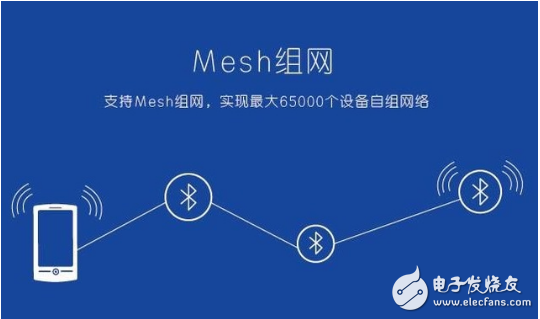Bluetooth technology is one of the world-renowned brands and one of the most widely used wireless communication technologies in the world. From 2000 to the present, Bluetooth technology has been widely used in billions of devices. As of 2016, manufacturers' shipments of Bluetooth devices are more than 3 billion units.
The pace of innovation in Bluetooth has never stopped. Since its introduction, Bluetooth has been rigorously rigorous, and every improvement has been systematically rigorous, keeping up with market demands and supporting and encouraging innovation.
The amazing story of Bluetooth technology continues, the Bluetooth mesh network has opened the latest chapter, and 150 Bluetooth technology alliance member companies have participated in the creation of mesh.
Bluetooth MESH currently uses the MESH network technology based on the flooding protocol. In the released version of the protocol, it is mentioned that a routing protocol based MESH network may be added in a future revision.
Indeed, the flooding agreement is a relatively primitive MESH network technology. Since the data packets in the network layer are sent and forwarded in the form of broadcast, a large number of repeatedly transmitted data packets are generated in the network, which has a large negative impact on the overall power consumption of the network. The current flooding MESH protocol is only suitable for networks with relatively small scales, and is not suitable for application scenarios where the amount of network data is relatively large.
Before introducing the network layer protocol, first understand the network architecture of BLE MESH.

There are four kinds of connections in the above picture, five kinds of nodes, which are introduced below:
Four connections:(1) ADV (Not Relayed): Two nodes can send and receive broadcast messages to each other, but because they are not relay nodes, they cannot relay data packets.
(2) ADV (Low power): used to send and receive data packets between the low powernode and the friend node, the connection between J and P in the above figure, and the connection between L and O. On this connection, the low power node will initiate a request to establish a friendship connection and query the friend node for its own data.
(3) ADV Bearer: The broadcast message can be sent and received between two nodes based on the adverTIsingbearer, and can be forwarded as a relay;
(4) GATT Bearer: For nodes without ADVbearer capability, it can also participate in the MESH network. For example, the node T can send and receive proxy PDUs on the GATT connection with other nodes through a proxy protocol.
Five kinds of nodes:(1) Node: The node at the edge of the network, without the relay function.
(2) Low power node: Low power node. Due to the presence of friendnode, the low power node does not need to always send or listen to data packets on the broadcast channel, which can save power. The Low power node only needs to periodically query its friend node for data to arrive.
(3) Relay node: It is the core node of the network layer extended network coverage. After receiving the data packets sent by other nodes, it determines whether it needs to be forwarded according to the network setting conditions.
(4) Friend node: As the proxy node function of low powernode, when the data of the low power node is released, it can be cached in the friend node, waiting for the low power node to query and obtain.
(5) Friend feature(not used): In the above figure, node N has a friendfeature, but it does not have a corresponding low power node, so the friend feature is not used.
Bluetooth Mesh will show strong application potential in the industrial field. The Bluetooth SIG pointed out that the automation of commercial buildings and factories will become an important market for wireless networking technology. Since these markets require true industrial-grade solutions, this is the advantage of Bluetooth Mesh technology.
Specifically, Bluetooth Mesh features stability, scalability, and security. In terms of stability, the technology's built-in self-healing capability avoids single points of failure to affect the online quality of the entire network. Expandability supports thousands of nodes and delivers industrial-grade performance. Security further provides industrial-grade security against all known attacks.
What is Bluetooth MeshThe Bluetooth Mesh network is a new network topology for Bluetooth Low Energy (also known as Bluetooth LE) for establishing many-to-many (many) device communication. It allows you to create large networks based on multiple devices. The network can contain dozens, hundreds or even thousands of Bluetooth Mesh devices. These devices can exchange information with each other. Undoubtedly, such an application form is building automation. Wireless sensor networks, asset tracking and other solutions provide the ideal choice.

To develop a smartphone or tablet application for use with Bluetooth Mesh networking products, which we often call an app, you must use the Bluetooth Mesh Proxy protocol to communicate with the mesh network through the proxy node. Regarding the proxy protocol, there is a very informative introduction in the sixth chapter of the Bluetooth Mesh specification. Here, a brief description of the proxy protocol is: the proxy protocol can be implemented on the standard low-power Bluetooth GAP and GATT APIs, and the application implements the predefined GATT service and features (CharacterisTIc). The proxy nodes in the Bluetooth Mesh communicate, and then interact with the Bluetooth Mesh network through the proxy node.
5.0 The improvement of the connection distance and the improvement of data efficiency, the relationship between them is not independent, but there are mutual constraints. It does not increase the connection distance by 4 times in the case where the transfer rate can be doubled. Furthermore, if you want the Bluetooth connection to be farther away, you need to reduce the transmission speed. If you want to transfer faster, you need to reduce the transmission distance. This kind of constraint relationship is understandable in the actual project implementation. Not all applications require the farthest connection distance and the highest transmission speed. Under the premise of certain power consumption, balance the speed and distance. The relationship is a factor that must be considered in application development and an important assessment of the strength of technology vendors.

How to increase the amount of Bluetooth broadcast information? In versions prior to 5.0, there were only three broadcast channels for Bluetooth. There are still some drawbacks to the actual application of the industry. However, in the upgraded 5.0, all data channels can carry broadcast information, and the actual effect is very powerful! Maybe many people still don't understand, is this increase meaningful? From a technical point of view, this is a major move by the Bluetooth Technology Alliance to enter the Internet of Things (IoT). Because the most basic theory of Mesh technology is based on the Bluetooth broadcast channel to establish connectionless communication, when designing Mesh technology at the beginning, the Bluetooth standard is still 4.0, so that only the pre-4.0 broadcast channel can be used to implement Mesh technology. The Bluetooth Technology Alliance has released the official Smart Mesh standard. It is clear that Bluetooth 5.0, which greatly increases the ability to broadcast data, is a good technical foundation for the development of Mesh.
8.4V Charger,8.4V Li-Ion Battery Charger,Battery Charger For Drone,Li Ion Battery Charger
ShenZhen Yinghuiyuan Electronics Co.,Ltd , https://www.yhypoweradapter.com